Issue 41: January 2002
CPBR NEWS
News from the Centre for Plant Biodiversity Research, Australian National Herbarium (CANB), for the information of CPBR and ANBG staff and volunteers.
CPBR News is produced monthly. If you wish to contribute, please email your suggestions to Val Oliver, the coordinator.
Val Oliver: ph (02) 6246 5533; fax (02) 6246 5249; email: Val.Oliver@csiro.au
1. Herbarium
New Curator the Australian National Herbarium appointed
Since Bob Makinson left the Herbarium to take up a position at Royal Botanic Gardens Sydney in May last year, Christine Cargill and Brendan Lepschi have been alternately acting in the position of Herbarium Curator while we realigned the position with our other Centre activities, and clarified the position in relation to the structural review of the ANBG; this proceeded very smoothly and both staff did an admirable job managing the herbarium during the extended transition period, with the herbarium running very smoothly without a hitch - thanks to both!
The selection process has now been completed and we are pleased to congratulate Brendan Lepschi on his appointment to the position of Curator of CANB, from January 10. This is an indefinite appointment and we look forward to the years ahead as Brendan guides the herbarium through the establishment of the Australia's Virtual Herbarium Project.
As so-called 'Botanical Services Officer' at CANB, Brendan and his dedication and enthusiasm for herbaria and collections will be familiar to us all. He is apparently very pleased about taking up the position and has already started invigorating curatorial activity in the collections.
In his new role, Brendan will be continuing management responsibility for APNI, and will be integrating plant nomenclature and data entry activities more closely into the overall curatorial process. He will also be taking more direct responsibility for loans for and on behalf of the Herbarium, so see Brendan in the first instance about any new loan requests.
A word of warning: Brendan is a self-confessed compulsive obsessive neat-freak. Anything left lying around in the herbarium will either be thrown out, filed in the compactus or arranged in neat vertical NS-EW oriented piles...
[Jim Croft and Judy West]
********************
2002 Interns Program - Hall of Shame
Another summer, another Intern field trip to Jervis Bay, and another anthology of infamy to report.
Judy West – for coming up with all manner of 'pressure of work' excuses as to why she could not attend the Interns field trip to Jervis Bay, then taking time off during the program and going to Narooma for a holiday, admittedly over a weekend.
Murray Fagg – for undergoing a major crisis of conscience self-guilt trip over taking two days out of the office to see plants and visit and photograph the Interns in action, in spite of the fact that this sort of paparazzi thing is part of his duty statement and performance agreement.
Christine Cargill – for wimping out on the privations of the field trip and going for just two days out of the four.
Judith Curnow, Heino Lepp – for wimping out of the field trip completely and not going at all.
Bob Makinson – for cleaning out every useful map of the Jervis Bay area from every botanical institution in the ACT for the last intern field trip and neglecting to return and file them after the event. Not only could the institutions not lend the maps, they wouldn't even if they had them.
Julie Matarczyk – for once again begging and pleading to be allowed to spend four days slaving over a hot stove and seething pots and pans, feeding two dozen glutinous souls – anything is less painful than databasing, it seems.
Julie Matarczyk – for establishing a tradition, following on from Julie Paul, that anyone called Julie will in future be called upon to cater for intern field trips. Anyone else wishing to do this job in future will have to change their name by deed poll, unless their name is already Julie.
Anthony Whalen – for getting so addled after one beer that he helped himself to two of Julie's Boags rather than his own Coopers, in spite of the fact that the latter is indeed beer, and the former… isn't.
Anthony Whalen, acknowledged rush expert – for confidently telling the Interns that what he had in his hand was without doubt Restionaceae, whereas if he had bothered to look at the sheathes he might have stumbled on the correct answer, Cyperaceae. In fact he may have done better flipping a coin – that way he would have only had a 50% chance of being wrong. So would have Bob Makinson, who did precisely the same thing, with even more confidence, two days later.
Caustis flexuosa (Cyperaceae), our first plant nomination. For pretending to be a member of the family Restionaceae. Sundry speakers confidently holding up a plant while espousing the wonders of the Restioid world in front of large crowds.
Gymnostachys anceps – who deep down is an aroid, but goes around dressed like a sedge.
Bob Makinson – for launching into long and informative speeches at the drop of a hat on topics largely unrelated to the current context. Sea Level changes and how they relate to a quick and dirty field survey for one.
Basically everyone – for neglecting to bring any music with the basic elements of melody, harmony, time, tune, etc. Come back Bob – all is forgiven.
Various interns – for being deferentially apologetic to aging Centre staff about choice of music tapes in the car. With teenage sons practising to be a wannabe megawatt lead guitar in the new Metallica-AC/DC punk/thrash/grunge/acid/rock fusion sensation, such staff can tolerate anything.
Intern beach party – for breaking into discriminatory male and female teams for beach soccer. Classification based on gender is not a sound foundation for taxonomy. But especially the blokes for a total disregard for government policies on affirmative action and winning by a whopping margin of two goals, 7-5.
Brendan Lepschi – for consuming two hamburgers and a steak sandwich for lunch, complaining that he had not eaten since breakfast. And for having double helpings of everything for dinner complaining that he had not eaten since lunch. And especially for remaining a long thin streak in spite of this. This display of gluttony continued throughout the trip, culminating at the Famous(!) Robertson pie shop where Anthony was shouting him lunch, ordering two large steak and mushroom pies (each about $9). It was politely pointed out that the large pie was about 20 cm across, a family pie. After some argument, he reluctantly settled for two normal pies.
Julie Matarzyck – for shamelessly promoting the 'sport' of frisbees at any opportunity, even in the enclosed kitchen work area.
Dave Mallinson – for giving intern Leanne Brown a brutal lesson in fielding at silly mid on (the image of ‘bowling a maiden over’ comes to mind). This was part of the combined cricket, Frisbee match in the BBQ area while a brave dedicated team of staff members tried to cook dinner.
Brendan Lepschi – for a string of truly appalling botanical puns such as 'Just remember who is the Bossiaea' and 'this is a plant that wishes to remain Eonymus'. And just itching for the opportunity of trying out to tired old classics of 'Acacia wondering…' and 'back in ten – Gompholobium'…
Jim Croft – for constantly turning up late when the convoy was ready to leave on the pretext of a last minute check. Are we waiting on Jim again?
Julie Matarzyck – who carried off the kitchen key (thus preventing access to all other room keys at the field station), leaving the interns out in the cold (or heat) while she and Jim and a selected number of interns stopped off for icy poles. All the remaining interns could do was start a slow hand clap and wait.
Dave Mallinson – for not realizing that dunes start above high water mark and taking his fore-dune survey team swimming while the other inland teams were sweating over hot plant presses in the blazing noonday sun.
Intern Ngaire Nunn, from sheltered Rockhampton – for gasping in horror the 'wave things' on the beach, describing the millpond like surf-ripple conditions as 'cyclonic'.
Brendan Lepschi – for a dream in which he was towing a trailer load of bricks to Moss Vale where he met Jim Croft delivering a lecture on stranger danger to a bunch of interns outside the public toilet block. Wonder what Freud and Jung would have made of that lot? You can get treatment for this sort of condition Brendan. Also intern Sharon Brown – for on the same night dreaming about intern Tom Tavener, dream in which Tom the serial homicidal maniac slaughtered the entire intern program in a most bloodthirsty and gruesome manner. OK Julie– what really went into that cooking?
Summer student Danielle Medek – for finding a kid's pink bike 'lost' in the bush at Manyana and riding it around the suburb's streets. And threatening to bring it back to Canberra to commute to and from the herbarium. Some poor child is almost certainly wondering what kind of person would steal her bike while they were at the beach that morning.
Bob Makinson – for slinking silently and heroically away Clint Eastwood fashion into the afternoon sun, as if to say 'my work here is done'…
And the joint winners this year clearly show that the management of the Intern Program next year is being placed in hands no less worthy than those organizing it this year:
Anthony Whalen – indisputable king of the leaving behind equipment thing. For leaving the GPS on the front of the field vehicle and driving off leaving it in the dust at Greenpatch. And for self righteously coming up with various after the fact justifications for this action, including:
Brendan Lepschi – for, in front of a lab full of impressionable young witnesses, bribing the local constabulary with a six pack of beer for returning the wayward GPS, demonstrating for the benefit of all interns present, the correct and proper way to conduct government business. And it gets worse – it was Anthony and Dave's beer he gave them. If the police got a six pack, what would the person who actually found the lost item and handed it in get? In Brendan's words: an official letter of thanks and appreciation. Yes indeed, rewards do not come any sweeter than that.
Can't wait 'til next year…
********************
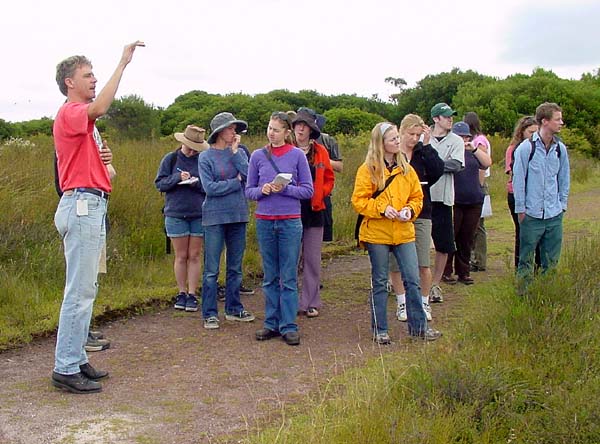
Brendan: "Ok all you little interns - even if you stand on tiptoes
you will
never be as big as I am"
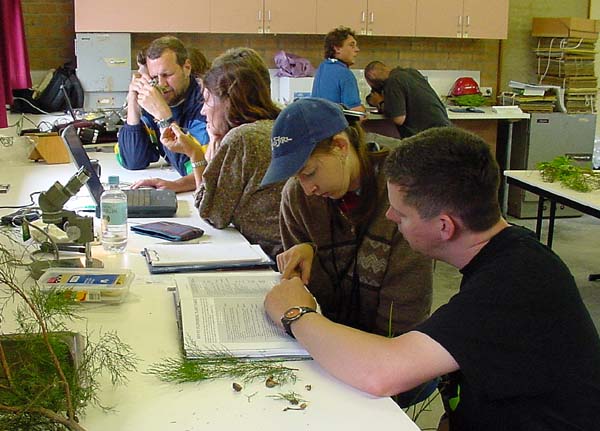
ID action in the lab
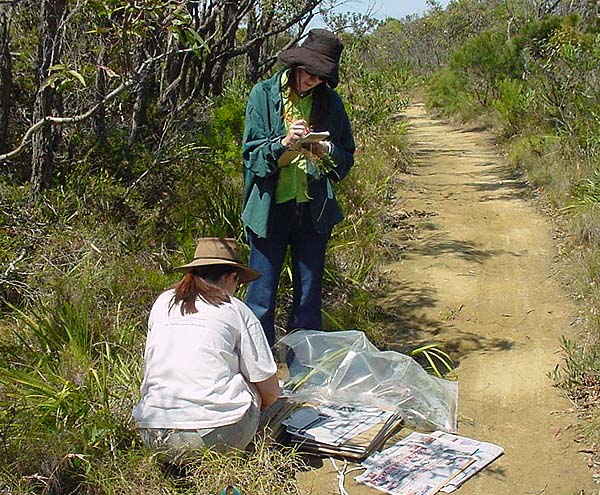
Hot press action in the field.
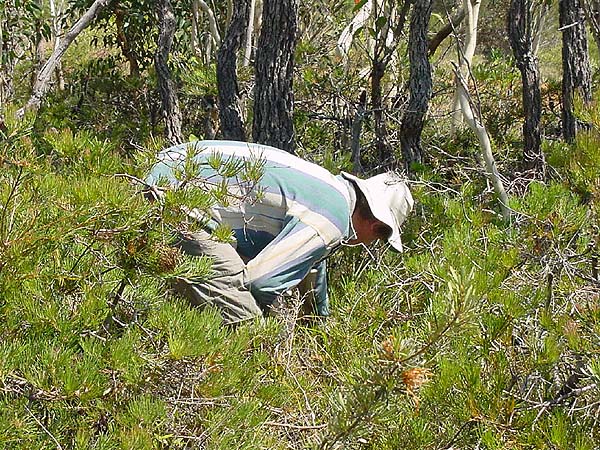
Justin, wondering if some surfer has stashed his board in the scrub somewhere
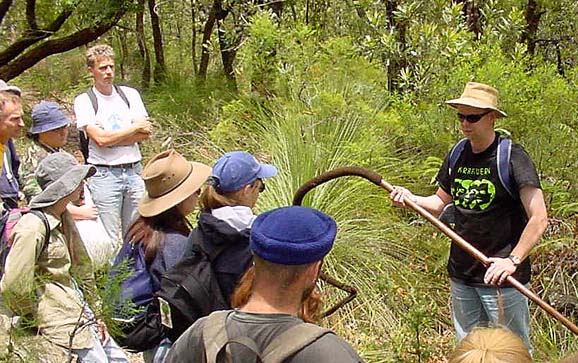
Anthony delivering a very stern lecture to the interns on the
perils of
excessive alcohol consumption.
********************
Australia’s Virtual Herbarium (AVH)
The "Australia's Virtual Herbarium (AVH) databasing Project" is finally underway. We would like to welcome Karen Thompson (full-time) and Carmen Evans, Maggie Nightingale and Theresa Orchard (all part-time) who have recently started as data entry technicians at the Centre. The remaining three team members, Di Lansdown, Robyn Prince and Kieran O'Shannassy (all part-time) will be coming on board in February. The AVH team can be found on Level 2 of Bldg 502 (the old wing) in Room 2.36, alternatively known as the "AVH Room" to avoid confusion with the "Computer Room" on Level 1 below.
Julie Matarczyk is heading up the team and data entry has begun with Hakea (Proteaceae). The grasses will be next with Terena Lally presently working through the genera checking the nomenclature and taxonomy of the specimens in readiness.
Another appointment for the herbarium databasing group, and partly funded by the AVH, is Lee Halasz who will join the Centre in early February. Lee’s role will be attending to the geographic side of the database, checking localities, latitudes and longitudes, retrofitting geocodes to specimens that do not have them and generally trying to get as many plottable points on maps as possible.
The AVH project is going to mean a huge increase in all aspects of herbarium activity - signs of this are already evident. Herbaria around Australia are showing signs of chasing outstanding loans, greater efforts are being made to get unprocessed material mounted and into the collection, and greater attention is being paid to curation and specimen identification.
The AVH will dominate herbarium activity for the next 5 years and ALL herbarium and systematics staff will be contributing to it in various ways. Completeness and accuracy of plant identification, and precision of collecting locality information will be receiving more attention than ever before as we go about building a truly powerful tool for botanical research and the greatest asset in the History of Australian botany. It is going to be a lot of hard work as we strive to meet our targets, but it promises to be a lot of fun and very rewarding along the way.
(ps. data entry and database construction, that highest form of human endeavour, is very taxing work - so if you see any AVH or herbarium staff sobbing in the corridors, please be kind to them and gently lead them back to the specimens and their keyboards...)
Jim Croft and Jo Palmer
********************
2. Research Groups
Sophie Bickford - New spatial analysis Postdoc for the Centre
A warm welcome to Sophie Bickford, recent PhD graduate from the University of Adelaide, who has just started in the Centre. Sophie comes with a vegetation analysis background with a special suite of spatial analysis skills that will be applied to investing distribution patterns in Australia's primitive vascular plants - the ferns and gymnosperms. Working with geographic information systems and spatial modelling software, Sophie will be using environmental models and specimen locality records from CANB and the Australia's Virtual Herbarium project to visualize, predict and interpret the biogeographic patterns of these plants. The project will run for three years and is funded by a grant from the Ken & Yasuko Myer Plant Science Research Fund.
Sophie is sharing an office with Postdoc Trudi Mullet, who has been nominated as an official 'peer support' person. This is the first implementation of a new program from Plant Industry's Human Resources, the first for the Division, and is designed to ease the transition of new staff into the organization, helping with learning where all the bits and pieces fit (and when Trudi and Sophie have it sorted out then they’ll let the rest of us know.)
Sophie brings a new set of GIS skills to the Centre that will enhance our handling of spatial data and add value to information in the herbarium databases. For all you people with spatial and mapping issues, it would probably be nice to let Sophie at least unpack her bags before asking her about your tired old data problems and first you have to join the queue...Sophie’s telephone number is 6246 4983.
[Jim Croft and Judy West]
********************
Summer Students
The summer students will present their seminars on 7 February in the Herbarium Tea Room. Please refer to seminar program on the back page of this newsletter.
[Val Oliver]
********************
3. Education and Communication
The NSW NPWS organised a BioBlitz of a 27 ha area in Kosciuszko National Park during the weekend of 12-13 January 2002 as part of activities for the Year of the Mountain. People came from various states to study, count or collect a wide variety of organisms. The aim was for the Parks to obtain a list of the biodiversity that exists in the Park, a list which would be more comprehensive than any previous lists they had.
Heino Lepp and I were able to participate, as did Cheryl Grgurinovic and Pat McCarthy of ABRS. Heino concentrated on corticioid fungi, probably the first time a mycologist had concentrated on this group of fungi in Kosciuszko NP. Cheryl was one of the mycologists who concentrated on leaf spot fungi, which have been only little collected for the area. Pat, the only lichenologist able to attend the weekend, concentrated on pyrenocarpous lichens. He is probably the first specialist of this group to collect in Kosciuszko and he found taxa not previously reported for the area. I concentrated on liverworts, especially looking for those of Chris Cargill's research families, and also collected some mosses which were fertile. Liverworts have been collected before in Kosciuszko, but our collections did not previously include ones from the BioBlitz site. There were other bryologists at the weekend, two concentrating on mosses and one other on liverworts. We worked different areas at different altitudes on the Sunday so we have distributional information for various taxa. Some of the liverworts are not on the previous lists for the Park and one (of which I found one population fertile) does not match the previously known species for the genus in Australia. I found some of Chris' taxa fertile, including samples of the genus Austrofossombronia that she specifically wants to study and which is rarely found with sporophytes in Australia. For most of her research taxa I collected fresh material as well as the herbarium specimen and Chris is now trying to cultivate these.
All cryptogamists who participated are very pleased with their findings and I understand all other participants are pleased with their results as well. The weekend was very productive, both from the point of view of the collections obtained and also for the chance to confer with colleagues. Now comes the task of fully identifying the specimens so as to get the list back to the Parks who wish to publish the combined results of the weekend by the end of this year.
We thank the NPWS for providing this opportunity.
[Judith Curnow]
********************
4. Information Technology and Data Management
Some major URLs to access databases for the Centre for Plant Biodiversity Research.
The Centre for Plant Biodiversity Research web site:
The Australian National Herbarium database:
http://www.cpbr.gov.au/cgi-bin/anhsir
The complete web view of the Australian Plant Name Index:
http://www.cpbr.gov.au/cgi-bin/apni
'What's Its Name?', a popular view of data from the Australian Plant Name Index:
The International Plant Name Index:
http://www.ipni.org/searches/query_ipni.shtml
Australia’s Virtual Herbarium:
http://www.chah.gov.au/avh.html
Searching the National Plant Photographic Index by plant name:
Searching the digitised images of the Photographic Index by family:
http://www.anbg.gov.au/images/photo_cd/
Council of Heads of Australian Herbaria
********************
5. General Centre Matters
Board meeting
A Centre Board meeting was held December 17. Since there were no critical issues to resolve, the Chairman Professor Derek Anderson ably guided the meeting via teleconference.
We took the opportunity to update the Board on a number of Centre activities, such as:
The major issue attracting considerable discussion was the extension to the Centre building, primarily to incorporate herbarium collection expansion space; a case is now being prepared.
John Hicks has taken long service leave for the year 2002, and David Kay will now be the second EA Board member for this period.
[Judy West]
Staffing changes
Besides the new staff mentioned above, Jenny Bailey is comfortably holding the fort in the front office in the Centre building on CSIRO site, while Alison is on maternity leave. Welcome to Jenny, who joined us following a recent job just over the fence in the ANBG.
Tony Willis resigned from his position at the Centre funded by the Weeds CRC, to take up a position in the Department of Health’s Office of Gene Technology Regulator (OGTR) - the successor to GMAC. Best wishes from the Centre to Tony in this new venture.
After 27 years working for CSIRO Bernie Hyland in our Atherton herbarium, retires February 15. Bernie’s contribution to our knowledge of Australia’s rainforests is unique and has provided an outstanding base for others to further the research of our flora. His foresight in developing the electronic Rain Forest Key (RFK) – initiated in the 1960s – stimulated others around the world to attempt something as ambitious. I haven’t yet seen an example covering a similar complicated flora that is as successful!
Judy, Jim Croft and David Jones will be in Atherton at the time of Bernie’s retirement. Bernie is intending to continue contributing to the RFK as an Honorary Research Fellow, after he has 2-3 months away from Atherton. Besides helping Bernie celebrate a new stage of life, Jim and David will be spending time with Bruce Gray and starting on the fern program for the RFK.
[Judy West]
********************
6. Other News
Centre for Plant Biodiversity Research seminars 2002
|
List of speakers and topics --- Centre for Plant Biodiversity Research seminars 2002 |
||||
|
Date |
Day |
Time |
Speaker |
Topic |
|
30-Jan |
Wed |
12:30 |
Mark Gardener |
The management of invasive plants in the Galapagos Islands |
|
7-Feb |
Thu |
12:30 |
Summer students |
Summer Student Symposium |
|
Danielle Medek: Is there more than one species in the Asterella drummondii complex of the NSW region? |
||||
|
Alison Skinner: Impact of tree isolation on seed set, seed size and viability in Eucalyptus benthamii |
||||
|
Alex Roberts: An assessment of species richness within the Labiate genus Teucrium in Australia |
||||
|
Radhika Murti: Variation in root set on selected Eucalyptus grandis cuttings |
||||
|
Luke Barrett: Ecological dynamics and coevolution in plant-pathogen metapopulations |
||||
|
7-Mar |
Thu |
12:30 |
Steve Rogers |
|
|
4-Apr |
Thu |
12:30 |
Christine Cargill |
The complexities of the simple Thalloid Liverwort suborder Fossombroniineae within Africa, Southwest Asia and India |
|
2-May |
Thu |
12:30 |
Linda Broadhurst |
Patterns of genetic variation in the West Australian flora |
|
6-Jun |
Thu |
12:30 |
Lyn Craven |
Sweeping the landscape: Broombush in Western Australia (Myrtaceae, Melaleuca uncinata and allies) |
|
4-Jul |
Thu |
12:30 |
||
|
1-Aug |
Thu |
12:30 |
||
|
5-Sep |
Thu |
12:30 |
Bob Godfree |
Ecological implications of transgenic pastoral plants |
|
3-Oct |
Thu |
12:30 |
||
|
7-Nov |
Thu |
12:30 |
||
|
5-Dec |
Thu |
12:30 |
Peter Thrall |
Theoretical and empirical studies of host-pathogen coevolution: The Linum-Melampsora |
[Seminar Coordinator: Bo Wang bo.wang@csiro.au 6246 4984]